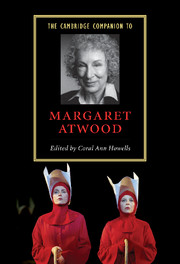Book contents
- Frontmatter
- Introduction
- 1 Margaret Atwood in her Canadian context
- 2 Biography/autobiography
- 3 Power politics: power and identity
- 4 Margaret Atwood’s female bodies
- 5 Margaret Atwood and environmentalism
- 6 Margaret Atwood and history
- 7 Home and nation in Margaret Atwood’s later fiction
- 8 Margaret Atwood’s humor
- 9 Margaret Atwood’s poetry and poetics
- 10 Margaret Atwood’s short stories and shorter fictions
- 11 Margaret Atwood’s dystopian visions: The Handmaid’s Tale and Oryx and Crake
- 12 Blindness and survival in Margaret Atwood’s major novels
- Further Reading
- Index
5 - Margaret Atwood and environmentalism
Published online by Cambridge University Press: 28 November 2006
- Frontmatter
- Introduction
- 1 Margaret Atwood in her Canadian context
- 2 Biography/autobiography
- 3 Power politics: power and identity
- 4 Margaret Atwood’s female bodies
- 5 Margaret Atwood and environmentalism
- 6 Margaret Atwood and history
- 7 Home and nation in Margaret Atwood’s later fiction
- 8 Margaret Atwood’s humor
- 9 Margaret Atwood’s poetry and poetics
- 10 Margaret Atwood’s short stories and shorter fictions
- 11 Margaret Atwood’s dystopian visions: The Handmaid’s Tale and Oryx and Crake
- 12 Blindness and survival in Margaret Atwood’s major novels
- Further Reading
- Index
Summary
“What is a human being?” This question, among others, constitutes what Atwood calls the “sub-sub-subtext” of her lecture delivered at Carleton University (Ottawa, Canada) in January of 2004, “Scientific Romancing: The Kesterton Lecture.” Primarily a lecture on science fiction, it also touches on themes that have informed her writing for several decades - despotism versus decency; obsessive control versus the spectrum of human desire; science and art; reason and the imagination - all of which contribute to her sense of the environment. How much imbalance in these pairs of terms can we tolerate? Or, as she says in her lecture, “How far can we go in the alteration department and still have a human being?”
The present is a turning point for Atwood. She states in the Kesterton Lecture and in her very short piece entitled “Writing Oryx and Crake” that, until now, the human animal has not changed. “What we want has not changed for thousands of years, because, as far as we can tell, human nature hasn’t changed either” (“Kesterton Lecture,” n.p.); and, “homo sapiens remains at heart what he’s been for tens of thousands of years – the same emotions, the same preoccupations.” Her view of the animal itself up to this turning point will emerge in analysis of her work. For now, keep in mind that given current scientific research we are able, for the first time, to alter that animal beyond recognition.
- Type
- Chapter
- Information
- The Cambridge Companion to Margaret Atwood , pp. 72 - 85Publisher: Cambridge University PressPrint publication year: 2006
- 12
- Cited by



